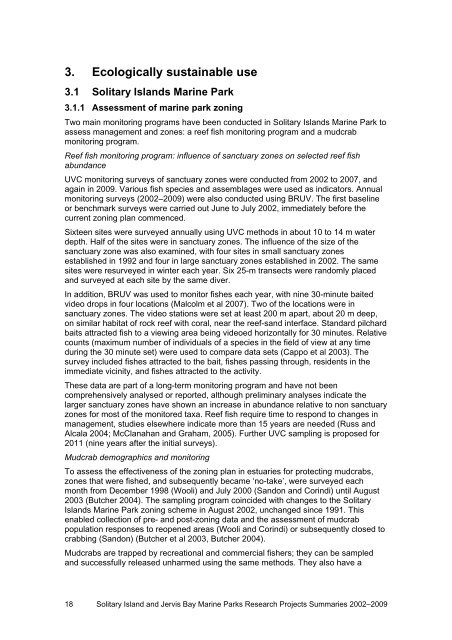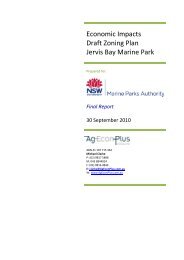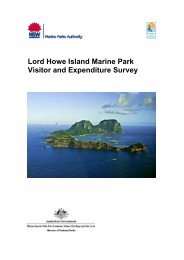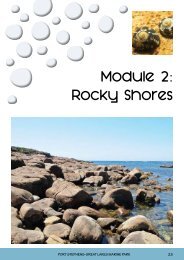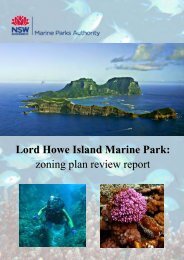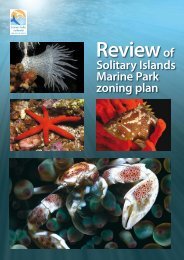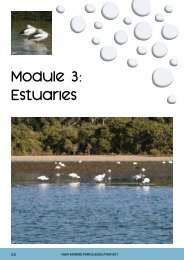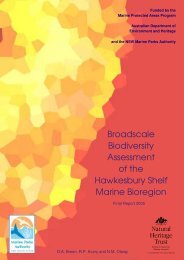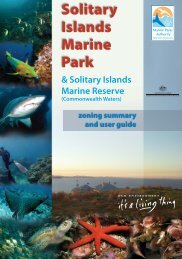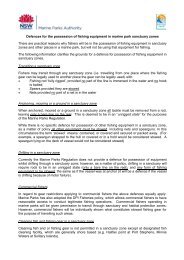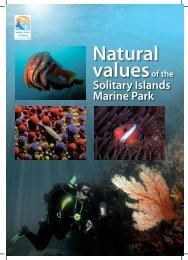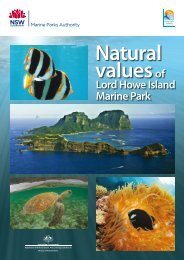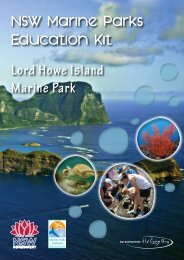Research Project Summaries 2002-2009 - Marine Parks Authority ...
Research Project Summaries 2002-2009 - Marine Parks Authority ...
Research Project Summaries 2002-2009 - Marine Parks Authority ...
Create successful ePaper yourself
Turn your PDF publications into a flip-book with our unique Google optimized e-Paper software.
3. Ecologically sustainable use3.1 Solitary Islands <strong>Marine</strong> Park3.1.1 Assessment of marine park zoningTwo main monitoring programs have been conducted in Solitary Islands <strong>Marine</strong> Park toassess management and zones: a reef fish monitoring program and a mudcrabmonitoring program.Reef fish monitoring program: influence of sanctuary zones on selected reef fishabundanceUVC monitoring surveys of sanctuary zones were conducted from <strong>2002</strong> to 2007, andagain in <strong>2009</strong>. Various fish species and assemblages were used as indicators. Annualmonitoring surveys (<strong>2002</strong>–<strong>2009</strong>) were also conducted using BRUV. The first baselineor benchmark surveys were carried out June to July <strong>2002</strong>, immediately before thecurrent zoning plan commenced.Sixteen sites were surveyed annually using UVC methods in about 10 to 14 m waterdepth. Half of the sites were in sanctuary zones. The influence of the size of thesanctuary zone was also examined, with four sites in small sanctuary zonesestablished in 1992 and four in large sanctuary zones established in <strong>2002</strong>. The samesites were resurveyed in winter each year. Six 25-m transects were randomly placedand surveyed at each site by the same diver.In addition, BRUV was used to monitor fishes each year, with nine 30-minute baitedvideo drops in four locations (Malcolm et al 2007). Two of the locations were insanctuary zones. The video stations were set at least 200 m apart, about 20 m deep,on similar habitat of rock reef with coral, near the reef-sand interface. Standard pilchardbaits attracted fish to a viewing area being videoed horizontally for 30 minutes. Relativecounts (maximum number of individuals of a species in the field of view at any timeduring the 30 minute set) were used to compare data sets (Cappo et al 2003). Thesurvey included fishes attracted to the bait, fishes passing through, residents in theimmediate vicinity, and fishes attracted to the activity.These data are part of a long-term monitoring program and have not beencomprehensively analysed or reported, although preliminary analyses indicate thelarger sanctuary zones have shown an increase in abundance relative to non sanctuaryzones for most of the monitored taxa. Reef fish require time to respond to changes inmanagement, studies elsewhere indicate more than 15 years are needed (Russ andAlcala 2004; McClanahan and Graham, 2005). Further UVC sampling is proposed for2011 (nine years after the initial surveys).Mudcrab demographics and monitoringTo assess the effectiveness of the zoning plan in estuaries for protecting mudcrabs,zones that were fished, and subsequently became ‘no-take’, were surveyed eachmonth from December 1998 (Wooli) and July 2000 (Sandon and Corindi) until August2003 (Butcher 2004). The sampling program coincided with changes to the SolitaryIslands <strong>Marine</strong> Park zoning scheme in August <strong>2002</strong>, unchanged since 1991. Thisenabled collection of pre- and post-zoning data and the assessment of mudcrabpopulation responses to reopened areas (Wooli and Corindi) or subsequently closed tocrabbing (Sandon) (Butcher et al 2003, Butcher 2004).Mudcrabs are trapped by recreational and commercial fishers; they can be sampledand successfully released unharmed using the same methods. They also have a18 Solitary Island and Jervis Bay <strong>Marine</strong> <strong>Parks</strong> <strong>Research</strong> <strong>Project</strong>s <strong>Summaries</strong> <strong>2002</strong>–<strong>2009</strong>


